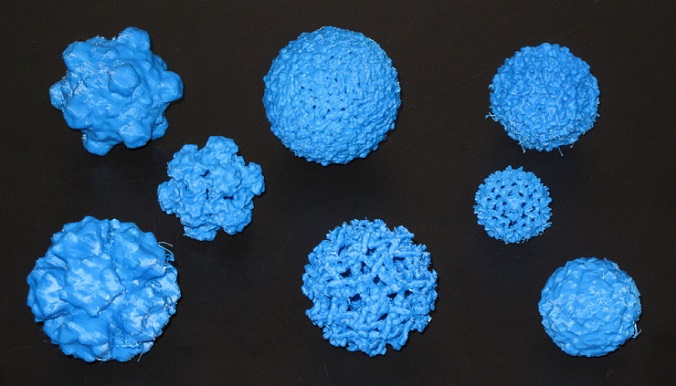-

Adenovirus
David J. Hall
Adenovirus, database # 2C6S Adenoviruses are medium-sized (90–100 nm), non-enveloped (without an outer lipid bilayer) icosahedral viruses with a double-stranded linear DNA genome. Adenoviruses are responsible for 5–10% of upper respiratory infections in children, and many infections in adults as well. The adenovirus is being tested as a gene therapy delivery vehicle as well as a treatment for a variety of cancers.
-

Dengue virus
David J. Hall
Dengue virus, database # 1THD Dengue fever, is an infectious tropical disease caused by the dengue virus and transmitted by mosquito. Symptoms include fever, headache, muscle and joint pains, and a characteristic skin rash that is similar to measles. In a small proportion of cases the disease develops into the life-threatening dengue hemorrhagic fever. Dengue is a positive strand RNA virus that is part of the flavivirus family. Dengue is an enveloped virus meaning it has a nucleocapsid protecting the RNA and the nucleocapsid is surrounded by lipids (hence the name enveloped).
-

Hepatitis B
David J. Hall
Hepatitis B, database # 2g33. Hepatitis B is an infectious inflammatory illness of the liver caused by the hepatitis B virus (HBV). Hepatitis B virus (HBV) is a member of the Hepadnavirus family.The virus particle, (virion) consists of an outer lipid envelope and an icosahedral nucleocapsid core composed of protein. These virions are 42 nM in diameter. The nucleocapsid encloses the viral DNA and a DNA polymerase that has reverse transcriptase activity.
-

Human Papilloma virus 16
David J. Hall
Human Papilloma virus 16, database# 1DZL Infection by most papillomaviruses is either asymptomatic or causes small benign tumors, known as papillomas or warts (e.g. human papillomavirus HPV6 or HPV11). Papillomas caused by some types, however, such as human papillomaviruses 16 and 18, carry a risk of becoming cancerous. Human papilloma virus is a non-enveloped, double stranded, circular DNA virus.
-

Parvovirus B19
David J. Hall
B19, database# 1S58. Parvovirus B19 virus is part of the parvovirus family and causes a childhood rash called fifth disease or erythema infectiosum that is commonly called slapped cheek syndrome. B19 is a non-enveloped virus whose capsid protects a single stranded linear DNA genome.
-

Phi X 174
David J. Hall
Phi X 174 database number # 1CD3. Phi X 174 is a virus that infects bacteria and was the first DNA-based genome to be sequenced in 1977. This bacteriophage has a [+] circular single-stranded DNA genome. The assembly of the capsid has been successfully done in vitro and is the focus of many studies on self-assembly, drug delivery and nanotechnology.
Virus genomes are protected by an outer protein layer called a capsid or nucleocapsid. Marvel at nature's beauty and the ability to self-assemble structures at the nanometer scale. These models are for teaching and fun!
Printing is not supported at the primary Gallery Thumbnail page. Please first navigate to a specific Image before printing.

